This page was
updated 12/27/08
![]()
This page was
updated 12/27/08
| Blackhawk
Bridge Lansing, Iowa Photos & history of the landmark bridge. 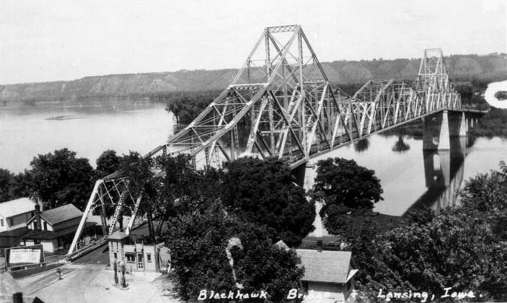 |
Crossing The Father of
Waters
A giant leap connecting Iowa and Wisconsin
by Barb Hagen
It is the late 1700's. Atop the bluff overlooking
a valley, which now nestles the town of Lansing, a native
American views the bluffs across the Father of Waters - the Great
Mississippi. The desire to cross the great expanse of water to
other hunting grounds siezes his thoughts. How will this
adventurer cross over?
The year is 1898. J.P. Conway and Tom Bakewell stand on the
streets of Lansing looking at the river traffic on the beautiful
Mississippi. J.P. says to Tom, "What can we do for
Lansing?" "It's too big even to think about,"
Bakewell replies. "I want to see a bridge across the
Mississippi here." The desire to link Iowa and Wisconsin has
grabbed the hearts of those dreamers. They wonder, are their
dreams impossible?
It is the fall of 1990. Engineers pour over maps of Lansing and
the Mississippi River. A desire to keep a safe link between
Lansing and DeSoto keeps them planning and developing. Dreams of
steel and concrete spanning the great Mississippi fill their
minds. A request to replace the existing bridge is made to the
Iowa Department of Transportation. Will there continue to be a
link across the Father of Waters for Allamakee County?
Desires can be fulfilled. Dreams can be built. The dream of Tom
Bakewell and J.P. Conway is now a beautiful silvery span 1,285
feet in length, 1,735 feet over all, with a clearance of 55 feet
above high water. The entire link between the bluffs is about two
and three-quarters miles. A roadway requiring 250,000,000 cubic
yards of dirt runs through the Winneshiek Bottoms. How was this
dream fulfilled?
In 1914 a committee was formed and incorporated as the Interstate
Bridge Company. Serving on the committee were J.P. Conway, Thomas
Bakewell, Moritz Kerndt, Fred Schafer, Julius Boeckh, and Captain
Harry Short. They received a charter in 1916 which was turned
over to the Iowa-Wisconsin Bridge Company in 1929. John A.
Thompson, Des Moines, served as president and V.W. O'Connor, St.
Paul, MN, served as chairman of the board. The chief engineer and
designer of the bridge was Melvin B. Stone from Minneapolis. J.N.
Gilbert of Lansing was resident engineer. Most of the
construction was done by the Industrial Engineering Company of
Minneapolis.
Hundreds of investors in Allamakee and Winneshiek counties
purchased shares in the company in order to erect the $750,000
Blackhawk Bridge. The Blackhawk Bridge was a toll bridge, a
popular form of investment at that time and was the first bridge
linking Iowa to Wisconsin.
Active work on the bridge began January 1930. Titanic amounts of
material were used. Erecting the bridge required 50 cars of
steel, 125 cars of stone and sand, 50 cars of bridge timber, 25
cars of piling and 3 cars of asphalt flooring. Forty cars of
cement alone were required. Bridge capacity was 30 tons, greatly
surpassing most existing bridge capacities of four, five or six
tons.
The largest item in construction was the center pier (the pier
which through the years has received blows from barges). This
pier rests on 143 piles, 40 feet deep, which are 55 feet below
the water. The pier itself required 1,800 cubic yards of
concrete. That's enough to fill a two-story building twenty feet
wide by sixty feet long to the top.
By August 1930 the seven piers on the east side of the river had
been completed. January 3, 1931 steel from Chicago reached
Lansing. The main bridge includes two cantilevers connected by a
swing span. Its two spans met May 22, and May 23 the Blackhawk
Bridge took final form.
Building the bridge at the start of the depression may seem risky
to people today. But financial conditions made it possible to
purchase the supplies cheaper than would have been possible a few
years earlier. Scarcity of construction work made it possible for
the company to secure favorable bids. Amazingly, no loss of life
or serious accident occurred during the construction of the
bridge.
The date is June 17, 1931. Lois Ann Schafer, age 5, stands in the
middle of an immense network of steel holding one end of a
ribbon. Across from her stands Virginia Dempsey, holding the
other end. Lois is excited about the upcoming days of
celebration. Standing in the middle of the Mississippi River on
the newly erected Black Hawk Bridge is the biggest event so far
in her life. Although Lois doesn't fathom the future
possibilities of a link between Wisconsin and Iowa, Senator S.W.
Brookhart of Iowa and L.J. Markwardt of Wisconsin understand the
meaning of this momentous occasion as they stand ready to untie
the ribbons, officially opening the Blackhawk Bridge. Now the
people of Lansing and Allamakee County will be able to cross the
Father of waters quickly and safely.
The ribbons were untied at the signal of aerial bombs set off
along the riverbank. The Lansing Band and the Dubuque Drum Corps
played the Iowa Corn Song. On the other side the Decorah Band
responded with "On Wisconsin." Chief Silver Tongue sang
"The Indian Love Call." Four days of festivities had
begun!
The first car to cross was occupied by Barney Graham of Decorah
who had paid $150 for that privilege. From the time the bridge
was officially opened to traffic, a continuous string of cars and
pedestrians crossed that first day. They payed somewhat less than
Mr. Graham. Toll rates had been established for everything that
could possibly cross the bridge. Automobile and driver, 50¢,
additional passengers each 10¢; motor trucks (1 1/2 tons) and
driver 75¢, each additional ton or fraction thereof 25¢; horse,
carriage and driver 50¢; motorcycle and rider 25¢; bicycle and
rider 10¢; pedestrians each 10¢; trailers (two-wheel auto
trailers) 25¢; livestock on hoof 10¢.
Many events were planned for that first day including: band
concerts on Main street and a flat boat under the bridge,
exhibitions by the drum corps, a gutsy high dive from the bridge,
surf board riding and other water sports. In the evening more
band concerts and beautifully lit boats floating down the river
for Ventian Nights provided entertainment. The evening concluded
with fireworks. The Lansing Band had been cautioned not to march
in step when crossing the new bridge. Worried officials didn't
want to take any chances that would damage the bridge's
structure.
Thursday was declared La Crosse Day. LaCrosse brought 200 cars
filled with over 1,000 people to the celebration. The delegation
from LaCrosse marched across the bridge headed by the LaCrosse
Concert Band. They also took charge of the program which lasted
far into the night. More band concerts and speeches were heard.
The evening was capped with fireworks and dancing. Long after
midnight cars were still crossing the beautifully illuminated
bridge, homeward bound.
Friday was declared Minnesota Day. "The Little German
Band" of Winona made a big hit. The Waukon School band also
held concerts on Friday.
Saturday was designated as All States Day with visitors from all
nearby states participating in the festivities. Former Lansing
and Allamakee county residents were given a
"homecoming" celebration in connection with the opening
of Blackhawk Bridge. And at 8 p.m. the much awaited "wedding
on the bridge" took place. Raymond C. Vaubel of Hollandale,
MN, and Pauline Stevens of Chicago were united in marriage. Chief
Silver Tongue sang and the newlyweds were presented with $25 in
gold from J.A. Thompson of the Iowa-Wisconsin Bridge Co. Venetian
Nights again closed the celebration.
It is June 20, 1931 about 10 p.m. The celebration of the opening
of Blackhawk Bridge is winding down. Hopes are high for
prosperity for Lansing and Allamakee County. What does the future
hold for the two great states - Iowa and Wisconsin?
Five-year-old Lois Schafer is at home two blocks from the bridge.
She looks at the lighted bridge and remembers the past days of
celebration. Going across the bridge was fun! It is also pretty
with all the lights reflecting off the river. Lois thinks it's an
adventure to cross the Mississippi on Black Hawk Bridge. She
falls asleep listening to the cars crossing above her and dreams
of Indians, led by Chief Blackhawk, quietly paddling canoes
through the water to reach the other hunting grounds.

It was the year 1930. A temporary bridge spanned the
Mississippi as construction of the Black Hawk Bridge began,
fulfilling dreams of a link between Iowa and Wisconsin.
~source of article & above photos: 1990 Allamakee
Journal newspaper clipping
~contributed by Errin Wilker
~~~~
BLACK HAWK HIGH BRIDGE
Today the carpenters are finishing
the last forms for Pier No. 2, and cement will be poured tomorrow
(Thursday), weather permitting, and the big structure completed.
As previously stated, excavating is finished for Pier No. 1, and
that will not take long to build. Steel work will then follow.
In the meantime, night and day, the drag line on the islands is
rapidly nearing the completion of their part of the work.
The city council last night passed the ordinances regulating the
grade and changes on Second street, and that part of the project
will be given attention in the near future.
--
The Black Hawk Bridge at Lansing is without question the most
important enterprise being developed at this time in northeastern
Iowa and the adjoining section of Wisconsin. This bridge will
affect every acre of ground, every head of livestock, every
business enterprise as well as every business and professional
activity. It is the fundamental link that northeastern Iowa has
long awaited and which is now fast becoming a reality.
To the Upper Mississippi Valley it means a large and increased
tourist business, a business that is rapidly assuming important
proportions nationally. It means the spending of thousands of
dollars along routes leading to the bridge and it means a large
traveling public awakening to the beauties of the Upper
Mississippi Valley, a district that has remained more or less
dormant from the tourists’ standpoint for many years.
The fact that many people from long distances now visiting and
watching the construction of Black Hawk Bridge speak of the
exceptional beauties of this rugged district bespeak the future
attractiveness of this region as a magnet drawing tourists to it.
Adjacent to the bridge lays a rich and productive territory. Many
prosperous communities and towns of size attest the splendid
natural resources obtained here. Probably no series of towns in
the state of Iowa represent more of prosperity and
progressiveness than the chain of towns on Iowa Highway No. 9
leading to the Black Hawk Bridge. Osage, Cresco, Decorah, Waukon,
etc.—these splendid communities will profit and grow as a
result of the Black Hawk crossing. A recent survey at Lansing
shows a greatly increased business in many lines of business from
out of town guests coming in to watch the construction of the
bridge. This increase will be many fold upon its completion. This
business will grow steadily as highways are improved and as
traffic increases. The business men of these communities are
receiving the increment from a public service enterprise, and if
prophecying is in order, it is our opinion that the great and
prosperous northeastern section of Iowa will be rediscovered and
its beauties and attractions made known to a great traveling
public. Thus the bridge will not only benefit transportation but
distribute its benefit economically to those who are awake to
take advantage of them in a business way.
~source: Allamakee Journal &
Lansing Mirror; October 22, 1930
~transcription by Ann Krumme
~~~~
BLACK HAWK BRIDGE NEWS
It will be of great interest to
our readers to learn that the concrete on the bridge is finished
and ready for the laying of the steel, which was ordered several
days ago. Of all the work in connection with the bridge, the most
difficult and dangerous has now been completed. The placing of
the steel is more or less routine work as each piece of steel
comes from the factory to the job cut, marked and ready to be
fitted into place by the steel workers. President John A.
Thompson and Mr. John W. Shaffer visited Lansing on Sunday. They
went over the entire situation and are making arrangements to put
on a double shift of workmen to rush the completion of the
bridge.
At a recent meeting of the Board of Directors held at the office
of the company, Mr. John A. Thompson, President of the Phoenix
Finance System and Subsidiary Corporations, was elected President
of the Iowa-Wisconsin Bridge Company and a member of the board.
Mr. Vernon W. O’Connor was elected Chairman of the Board and
the following business men were added to the Board of Directors:
A. B. Wilder, President of University State Bank, Minneapolis,
Minn., President Lyle Culvert Co., Minneapolis, Director
Marquette National Bank, Minneapolis. H. T. Wagner, Sheriff Black
Hawk County, Iowa, and Waterloo business man.
On Saturday evening, Nov. 1, the officers of the Bridge Co. gave
a stag dinner at the Andrews Hotel. The dinner was followed by a
business meeting. Guests of the officers included members of the
Board of Directors, the salesmen, Dr. P. F. Meyer of Faribault,
Mr. Sven A. Norling, Hydraulic Engineer, Minneapolis, and Mr. M.
B. Stone, Structural Engineer, Minneapolis.
During the past week letter of notification were mailed for the
stockholders annual meeting to be held at the offices of the
company in Minneapolis on November 11th.
Mr. T. H. Bakewell of Lansing, Iowa, Vice-president of the
company, was a visitor at the Minneapolis office for several days
during the past week.
A. Thompson and wife of Des Moines, and John W. Shaffer and wife
of Minneapolis, were inspecting progress of the bridge work here
Sunday. The former gentleman is a Des Moines capitalist, who has
succeeded Mr. V. W. O’Connor as president of the
Iowa-Wisconsin Bridge Co. Mr. O’Connor has other pressing
business matters to look after, including the Alma bridge project
and Mr. Thompson will devote his entire time to Black Hawk
bridge. They found everything going along rapidly under the
direction of the new foreman, Mr. Nels Nelson. Work on Pier No. 1
is about completed and excavating done for the wings and
retaining wall on Second street. This wall starts in front of C.
N. Smedsrud’s doorway at the street level and raises to a
height of 8 ½ feet in front of the take off of the bridge. The
same procedure will take place on Second street, north of the
bridge. A sidewalk will be built from R. A. Dunlevy’s corner
around under the bridge, coming out at James Doyle’s. The
walk on the west side of Second street will be raised even with
the fill, railed in and a crossing put in at Mrs. Serena’s,
for the accommodation of people north of the bridge. The sidewalk
on Ballou street, running East and West, will remain as at
present.
The scaffolding on big Pier No. 2 is being taken down, and it now
looms up in all its majestic grandeur. It is pronounced by many a
more imposing structure than Pier 3, not having the cross section
above the pillars and below the arch, having but one opening
below the arch.
The toll house will be built on the wing, south of the bridge,
about 16 to 20 feet square, and will be a beautiful little
structure, built in the form of a Indian fort, enclosed in a
stockade. Besides the toll keeper’s office, it will contain
ladies and gent’s rest rooms, with storage rooms for fuel,
etc., in the basement, and will be a model in this line.
O. L. Buchanon and C. M. Powell of Viroqua, Wis., were viewing
the Black Hawk bridge for the first time Sunday. The former is a
retired business man of Vernon County’s capital city and the
latter is engaged in tailoring and was a former resident here and
at Waukon, whither they went from here. They drove via LaCrosse,
about 100 miles to get here and were going back through McGregor
and Prairie du Chien, about the same distance, whereas with the
high bridge in operation Viroqua would be only thirty miles
distant. Both were much interested in the progress of the project
and the former thought his city would be a fruitful field for a
good stock salesman.
DeSota Argus: With day and night shifts at work on the
surfacing of highway 82 is gong along at a rapid pace and at the
rate they are going it isn’t going to take long to finish
the job. With this completed the road will be one of the finest
in this section and it is hoped that the entire stretch will be
improved next year.
~source: Allamakee Journal &
Lansing Mirror; November 5, 1930
~transcription by Ann Krumme
~~~~
First Shipment of Steel for the Bridge
WESTERN UNION:
Chicago, Ill., Dec.29, 1930. 4:52 PM
Iowa-Wisconsin Bridge Co.
1000 Phoenix Building
Minneapolis, Minn.
Two cars of steel left Chicago for Lansing today. Final shipment
90 foot span Wednesday.
McClintic Marshal Company.
The above is a copy of a telegram phoned the Journal
from Minneapolis about 5 o’clock Monday afternoon by Mr. O.
R. Thorson, Treasurer of the Iowa-Wisconsin Bridge Company and
speaks for itself. Workmen are busily engaged since Monday on
both sides of the river, preparing for its erection, and the big
drag-line is operating night and day on the last stretch of the
dyke, in plain view of town.
V. W. O’Connor, Chm. Board of Directors, St. Paul, and John
W. Shaffer and J. W. Dempsey, Directors, of Minneapolis and
Lansing, respectively, were in consultation at De Soto, Monday,
relative to some important matters. Mr. Shaffer’s little
daughters, Betty and Lucille, accompanied him and enjoyed their
first sight of Black Hawk Bridge, Chris Peterson taking them in
charge and showing them around.
The crew of Jansen & Russell, who have been putting in the
dike across the bottoms, left Tuesday for Olivia, Minn., where
they will spend the holidays. On their return they expect to stay
at Lansing as they have about a week’s work on that side and
it is too far for them to travel back and forth from here. When
they finish that piece they probably will not be able to do any
more until next spring when they will have some finishing work to
do.—DeSoto, Argus.
Concrete Work on Bridge Completed
LaCrosse Tribune, Dec. 29.
DeSoto, Wis., --(Special)—Concrete work on the three quarter
million dollar bridge across the Mississippi river two miles
south of here is completed, and the laying of steel is soon to be
in full swing. A representative of the Iowa-Wisconsin Bridge
Company, promoters and builders of the bridge, is in Chicago
supervising and inspecting the steel fabrication. A number of
cars from the steel company containing heavy tools, derricks and
material have arrived.
The laying of the steel this winter will be more or less routine,
it is said, as each piece of steel comes from the factory cut,
marked, and ready to be fitted into place by the steel workers.
The present low price of steel is reported to have saved the
builders thousands of dollars.
A grading crew is rushing work on a dirt dike two and one half
miles long across the bottomlands from the main channel to the
Wisconsin shore. The men are working in three shifts day and
night, seven days in the week to get the work done before severe
cold freezing the ground too hard. About two weeks more will be
required, it is said. The dike is to run from the east end of the
bridge to Wisconsin state highway 35, the main artery of travel
between LaCrosse and Dubuque. An overpass above the Burlington
railway tracks just west of the intersection with 35 is to be a
part of this approach and is under construction.
The structure is of the cantilever type and will have an
elevation at high water of 55 feet above the channel. Nine
concrete piers now rise white and impressive, seven on the east
side of the channel, two on the Iowa side. The seven east piers
graduate in height, one after the other from the island into the
channel, the last and tallest one being 75 feet above the
Mississippi at the river’s present level. A pier of this
same height towers at the Iowa shore, and another one is on the
Iowa hillside. The main bridge span is 650 feet long.
The whole bridge from the west end on the Iowa hill at Lansing to
the Wisconsin bottomlands will measure 1,300 feet.
It is to be a toll bridge and is being entirely financed by the
sale of stock. The number of stockholders at the present time is
given as well over 300. Stock, according to T. H. Bakewell of
Lansing, often called the “father of the Black Hawk
Bridge,” has been taken in large blocks in Minneapolis,
considerable has been sold in Chicago, Waterloo and Mason City,
and large amounts in the aggregate have been taken in Waukon,
Decorah, Lansing and other Iowa towns which expect to directly
benefit from the bridge.
Headquarters of the company are in Minneapolis. John Thompson,
Des Moines, is president; T. H. Bakewell, vice president; M. E.
Lockhart, Minneapolis, secretary and treasurer. Vernon W.
O’Connor, Minneapolis, is chairman of the board of
directors. Associated with him on the board, besides the officers
are: J. W. Dempsey, Lansing; Edward O’Connor, Sacred Heart,
Minn.; C. H. Young, Minneapolis; William Ellsbury, Minneapolis;
H. T. Wagner, Waterloo and A. B. Wilder, Minneapolis.
In speaking of the important services to be rendered the Iowa and
Wisconsin motoring public by the new bridge, Mr. Bakewell
emphasized that there is no highway bridge at this time spanning
the Mississippi between LaCrosse and Dubuque, a distance of 131
miles. It will link tourist and commercial travel routes of the
four states, Iowa, Wisconsin, Minnesota and Illinois, he pointed
out, and afford a short motor route from Minneapolis and St. Paul
to Madison, Milwaukee and Chicago. On the Iowa side the bridge is
to connect with primary road No. 9, the most northern of the five
main east and west Iowa highways. No. 9 from Waukon to Lansing
has been called “the road of a thousand curves.’ It
goes winding down a lovely valley, between rolling fields past
woodlands to Lansing, thence down its sloping main street to the
very edge of the Mississippi. Two blocks north the bridge is
located.
The name of Black Hawk has been chosen for the bridge, because it
was at the Battle Island just north of Lansing and De Soto that
the great Indian chief, Black Hawk, and his braves made their
stand against the white man and went down to defeat, bringing to
an end Indian occupation of Wisconsin and opening eastern Iowa to
settlement.
The toll house of the bridge will carry out this Black Hawk
memorial idea. It is to be in the form of an Indian fort enclosed
in a stockade. On the signs leading to the bridge it is planned
to have an Indian with drawn bow and arrow.
~source: Allamakee Journal &
Lansing Mirror; December 31, 1930
~transcription by Ann Krumme
~~~~
The Toll House
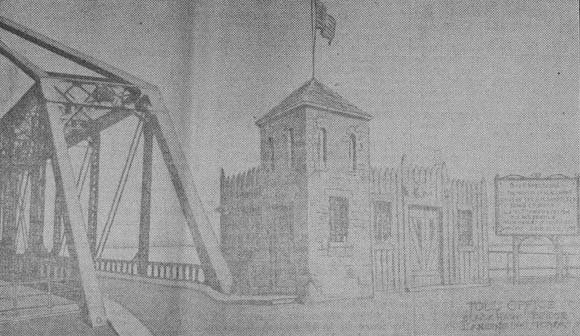
This picture shows the toll house on the Iowa side of the new $750,000 Black Hawk Bridge spanning the Mississippi river between Lansing, Iowa, and DeSoto, Wisconsin, and which is rapidly nearing completion. The toll house probably is the most novel and interesting structure of its kind in the United States inasmuch that it follows out an idea which prevailed in the pioneer days of the Hawkeye and Badger states, that of the stone fort and log house or blockade so well known to the early settlers of these two states who used this style of structure in defense of themselves and their families from the invasions of the hostile Sacs and Foxes under the leadership of Chief Black Hawk. To the right of the toll house in the photograph is shown the architect's conception of a large bronze tablet to be erected close to the entrance to the bridge and upon which will be inscribed the following:
Black Hawk Bridge
To the Memory of Black Hawk Chief of the Sacs and Foxes To His Courage, Loyalty and Devotion For His People
Born 1767
Died October 31, 1838
High Bridge News Notes
-John W. Shaffer and V. W. O’Connor, of the Iowa-Wisconsin
Bridge Co., and Ben Storey, Supt. of the Industrial Construction
Company, builders of the bridge, were in the city part of
yesterday and the day before, leaving for the Wisconsin side,
where most of the crew is now engaged, save those erecting the
steel.
-The Leas digger finished the fill on Second street and the old
Thomas lot Monday and is to be shipped to the east approach of
the bridge, where it crosses the Burlington, to widen the road
there.
-A good job has been done on Second street, under the supervision
of Chris. Peterson. The work is only temporary, of course, and ,
after settling, will be replaced in the spring by work of a
permanent character. It is not going to be nearly so unsightly or
damaging to property as many had supposed.
-Another car of 3 and 4-inch plank for flooring and scaffolding
for the bridge was unloaded Monday, and more will come in as
needed.
-The war department approved the plans of the Iowa-Wisconsin
Bridge Company for the approach to the bridge under construction
across the Mississippi river at Lansing, Iowa, according to a
Washington, D. C., dispatch of Wednesday last.
-Laying of steel for the approach on the east side of the bridge
was started Tuesday and it is expected that the five 90 foot
spans will be completed within two weeks. The work will go ahead
rapidly now and the only thing that will delay the early
completion of the bridge will be the failure of the steel to
arrive.
~source: Allamakee Journal, Lansing,
Iowa; January 28, 1931
~transcriptions by Errin Wilker & Ann Krumme; photo from Ann
Krumme
~~~~
The Blackhawk Bridge Is Born
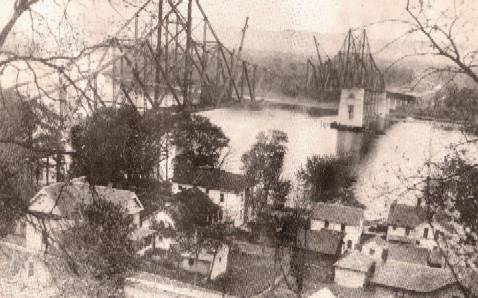
The trees were just beginning to bud in the spring of 1931 when the two sides of the Blackhawk Bridge met over the channel of the Mississippi River.
The Original Dedication
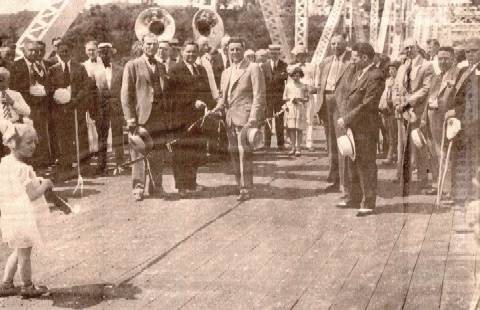
Lois Ann (Schaffer) Rosen (foreground) was just a
little girl in 1931 when she and Virginia Dempsey (holding other
end of ribbon) had the honor of cutting the ribbon which opened
passage of the Blackhawk Bridge for traffic.
~source: Allamakee Journal, June 1991
~contributed by Errin Wilker
~~~
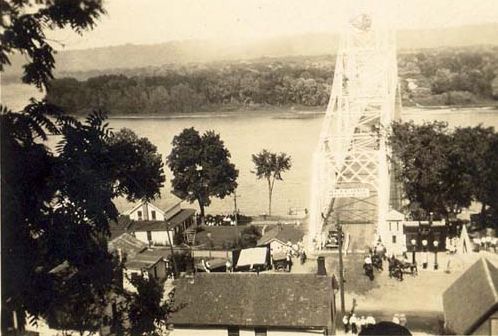
Blackhawk Bridge, Lansing, Iowa
~contributed by Shirley Taylor
~~~~~
Memorial Tablet for the Lansing Bridge
No monument is more commemorative of the
achievements of men and events than the Great Bridge, says the Lasing
Journal. It stands in steel and stone, defying the elements,
beckoning to the past and challenging the future. It serves not
only as a mere ornament and embellishment to its surroundings --
it is a memorial serving the practical needs of humanity..... the
Iowa-Wisconsin Bridge Company has caused to be spread on its
minute books the following record: "Upon completion of the
Trans-Mississippi Bridge spanning the Mississippi and connecting
the states of Iowa and Wisconsin, a suitable bronze tablet shall
be struck and appropriately emblazoned and embedded on the bridge
structure." It shall bear the following inscription:
BLACK HAWK BRIDGE To the Memory of Black Hawk Chief of the Sacs and Foxes To His Courage, Loyalty and Devotion For His People This Tablet is Inscribed Born 1767, Died October 31, 1838 |
The appropriateness of the Black Hawk Bridge as a
memorial to the Great Indian chief is realized from the fact that
four miles north of the bridge site, on the Wisconsin side, is
located what is known as the Black Hawk battle ground, where
occurred probably the most important engagement in the Black Hawk
War. This was known as "The Battle of the Bad Axe". All
of the territory adjacent to the bridge is rich in the traditions
of the Sac and Fox Indians and their Great Leader, and on the
right-of-way to the bridge descendants of the old Sac and Fox
tribes are now living. Thus the memory of Chief Black Hawk and
the rich Indian lore of this great scenic section is perpetuated
in the Black Hawk bridge.
~source: Postville Herald, May 15, 1930
~contributed by Sharyl Ferrall